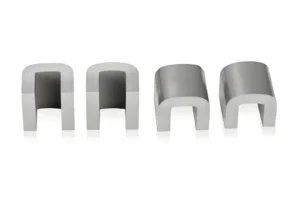
Introduction
Overview of Transformer Alloy Cores
Transformer alloy cores, which include materials like amorphous metal alloys or nanocrystalline alloys, have become essential components in modern transformer design. These alloys are highly regarded for their superior magnetic properties, such as reduced core losses and enhanced permeability. They are particularly well-suited for applications that require high efficiency and reliability.
What are Transformer Alloy Cores?
Definition and Basic Structure
Transformer alloy cores are typically made from materials like:
Amorphous Metal Alloys: These alloys have a non-crystalline atomic structure, which reduces magnetic losses (eddy currents and hysteresis losses) compared to traditional materials.
Nanocrystalline Alloys: These alloys have a fine crystalline structure with grain sizes in the nanometer range, offering high permeability and low core losses.
A transformer alloy core is structured with thin strips or ribbons of these alloys, wound or stacked in specific configurations. This design maximizes magnetic flux density and minimizes losses, improving overall efficiency.
Comparison with Traditional Core Materials like Silicon Steel
Advantages of Using Alloy Cores in Terms of Efficiency and Performance
Reduced Core Losses: Transformer alloy cores have lower eddy current losses and hysteresis losses compared to traditional silicon steel cores. This reduction in losses leads to higher efficiency in power transmission and distribution.
Improved Permeability: Alloy cores offer higher magnetic permeability, which means they can handle higher magnetic flux densities without saturating. This property allows for smaller core sizes and lighter transformers for the same power rating, reducing material and transportation costs.
Enhanced Reliability: Due to their stable magnetic properties, alloy cores exhibit consistent performance over time. They are less susceptible to temperature variations and aging effects, ensuring reliable operation throughout the transformer’s lifespan.
Environmental Benefits: Lower losses in alloy cores contribute to energy savings and reduced greenhouse gas emissions, aligning with global efforts towards sustainable energy practices.
In summary, alloy cores signify a notable advancement in transformer technology, providing superior efficiency, enhanced performance, and increased reliability compared to traditional core materials such as silicon steel. These attributes have made them increasingly preferred in modern electrical engineering applications where energy efficiency and reliability are crucial.
Future Trends and Innovations in Transformer Alloy Cores
Advanced Materials
Next-Generation Amorphous Alloys: Ongoing research aims to develop new compositions of amorphous metal alloys with even lower core losses and improved magnetic properties. These alloys could further enhance the efficiency of transformers, contributing to reduced energy consumption and operational costs.
High-Performance Nanocrystalline Alloys: Advances in nanotechnology are facilitating the development of nanocrystalline alloys with enhanced magnetic permeability and reduced losses. These alloys offer potential improvements in transformer performance, particularly in terms of power density and reliability.
Innovative Designs
Integrated Core Structures: Future transformers may incorporate innovative core designs that optimize magnetic flux distribution and minimize losses. Techniques such as advanced winding configurations and optimized core geometries could further enhance efficiency and reduce size and weight.
3D Printing of Core Components: Additive manufacturing technologies are being explored for producing transformer cores with complex geometries and tailored magnetic properties. This approach could enable customized designs that maximize performance while reducing manufacturing waste.
Impact on Efficiency, Sustainability, and Performance
Enhanced Efficiency: Continued advancements in alloy core materials and designs are expected to significantly reduce core losses, leading to higher overall transformer efficiency. This improvement not only lowers energy consumption but also contributes to the economic viability of energy distribution systems.
Sustainability: Lower losses in transformer alloy cores contribute to energy savings and reduced greenhouse gas emissions, supporting global sustainability goals. The adoption of advanced materials and manufacturing techniques also reduces material waste and enhances the lifecycle sustainability of transformers.
Improved Performance and Reliability: Future transformer alloy cores are poised to deliver enhanced performance metrics, including improved voltage regulation, reduced noise levels, and increased reliability under varying operating conditions. These advancements are critical for maintaining stable electrical grids and ensuring uninterrupted power supply.
Impact on the Future of Electrical Infrastructure and Energy Efficiency
Grid Modernization: Transformer alloy cores play a pivotal role in grid modernization efforts by enabling the deployment of more efficient and compact transformers. This facilitates the integration of renewable energy sources, enhances grid stability, and supports the transition towards smart grid technologies.
Energy Efficiency Regulations: Increasing global awareness of energy efficiency is driving regulatory frameworks that incentivize the adoption of high-efficiency transformer technologies. Transformer alloy cores, with their superior performance characteristics, are well-positioned to meet stringent efficiency standards and regulations.
Technological Integration: The integration of advanced transformer alloy cores with digital monitoring and control systems enables real-time performance optimization and predictive maintenance. This holistic approach enhances the operational efficiency of electrical infrastructure while minimizing downtime and maintenance costs
In conclusion, ongoing advancements in transformer alloy cores are pivotal for enhancing electrical infrastructure, improving energy efficiency, and promoting sustainability. By utilizing emerging materials and innovative designs, transformer technology is set to transform energy usage and bolster the resilience of modern electrical grids.